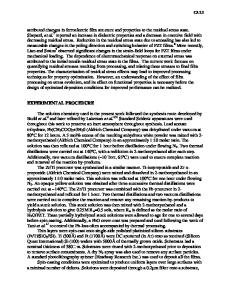Residual stress in electrodeposited nanocrystalline nickel-tungsten coatings
- PDF / 473,641 Bytes
- 14 Pages / 584.957 x 782.986 pts Page_size
- 8 Downloads / 337 Views
Characterizing the residual stress of thick nanocrystalline electrodeposits poses several unique challenges due to their fine grain structure, thickness distribution, and matte surface. We use a three-dimensional profilometry-based approach that addresses each of these complicating factors and enables quantitative analysis of residual stress with reasonable accuracy. The specific emphasis of this work is on thick (10–100 lm), nanocrystalline Ni-W electrodeposits of the finest grain sizes (4–63 nm), in which residual stresses arise during the deposition process as well as during postdeposition annealing. The present measurements offer quantitative insight into the mechanisms of stress development and evolution in these alloys, suggesting that the grain boundary structure is out of equilibrium (unrelaxed) and contains the excess free volume that controls the resulting residual stress levels in these films. There are apparently two factors contributing to this stress: the percentage of excess free volume contained in the grain boundaries, which is affected by the processing conditions, and the total volume fraction of grain boundaries, which is controlled by the grain size.
I. INTRODUCTION
When the grain size of a material is refined into the nanometer range, a significant volume fraction of atoms is located in the grain boundaries, and the interfaces begin to play a dominant role in shaping both its physical and mechanical properties. The resulting ultrahigh yield and fracture strengths, as well as other beneficial properties observed in nanocrystalline metals, have continued to stimulate interest.1–8 Electrodeposited nanocrystalline Ni-W alloys in particular have found wide application for coatings due to their high hardness, excellent corrosion and wear resistance, and ease of processing.9–12 However, as with many coating technologies, residual stress in nanocrystalline deposits can lead to detrimental effects including a decrease in fatigue strength, cracking under service conditions, or delamination.13–15 In advanced electronics and microelectromechanical systems applications, warping of the underlying fine-scale substrate features can also occur when a coating is applied or upon subsequent thermal treatment.16 The prospect for component failures due to such internal stress issues continues to be a technology-limiting barrier, and thus understanding their origins and controlling them is of great practical importance. a)
Address all correspondence to this author. e-mail: [email protected] This author was an editor of this journal during the review and decision stage. For the JMR policy on review and publication of manuscripts authored by editors, please refer to http://www.mrs. org/jmr-editor-manuscripts/ DOI: 10.1557/jmr.2012.51 J. Mater. Res., Vol. 27, No. 9, May 14, 2012
Despite the significance of residual stress in nanocrystalline coatings of every kind, quantitative measurement of these stresses is experimentally challenging due to the complexities arising from their structure and processing history. For example, wher
Data Loading...











